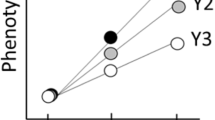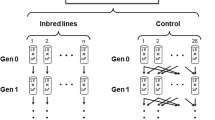Abstract
ELUCIDATION of the nature of the gene interactions that underly the sterility of interspecific hybrids is important in evolutionary biology1,2. The interactions between the heterospecific X and Y (or Z and W) chromosomes are often used as an explanation for two reasons. First, the fertility of the hybrids of the heterogametic sex is much more often affected than that of the homogametic sex (Haldane's rule3) and X–Y interactions are specific to the heterogametic sex. Second, sex chromosomes, especially the X chromosome, are often considered to be of special importance in determining the fertility of hybrids1,2,4. X–Y interactions have been addressed in studies of males with a heterospecific Y chromosome in a mixed genetic background5–8. A more stringent test of the X–Y interaction model requires each X chromosome sterility factor to be tested separately for its interaction with the Y chromosome in a homogeneous background of the pure species. Here we report such a test of the X–Y interaction model and conclude that X–Y interactions should not be assumed to be the only or even the most common cause of hybrid sterility.
This is a preview of subscription content, access via your institution
Access options
Subscribe to this journal
Receive 51 print issues and online access
$199.00 per year
only $3.90 per issue
Buy this article
- Purchase on Springer Link
- Instant access to full article PDF
Prices may be subject to local taxes which are calculated during checkout
Similar content being viewed by others
References
Dobzhansky, T. Genetics 21, 113–136 (1936).
Muller, H. J. in The New Systematics (ed. Huxley, J. S.) 185–268 (Clarendon, Oxford, 1940).
Haldane, J. B. S. J. Genet. 12, 101–109 (1922).
Coyne, J. A. & Orr, H. A. in Speciation and its Consequences (eds Otte, D. & Endler, J. A.) 181–207 (Sinauer, Sunderland, Massachusetts, 1989).
Coyne, J. A. Nature 314, 736–738 (1985).
Orr, H. A. Genetics 116, 555–563 (1987).
Hennig, W. Adv. Enz. Regul. 15, 363–371 (1977).
Orr, H. A. Evolution 43, 180–189 (1989).
Coyne, J. A. & Charlesworth, B. Heredity 62, 97–106 (1989).
Wu, C.-I. et al. in Molecular Paleo-population Biology (eds Takahata, N. & Clark, A. G.) (Springer, Berlin, in the press).
Johnson, N. A. & Wu, C.-I. Genetics 130, 507–511 (1992).
Livak, K. Genetics 107, 611–634 (1984).
Oka, H. Genetics 77, 521–534 (1974).
Wu, C.-I. & Beckenbach, A. T. Genetics 105, 71–86 (1983).
Pantazidis, A. C. & Zouros, E. Heredity 60, 299–304 (1988).
Jones, J. S. & Barton, N. Nature 314, 668–669 (1985).
Clark, A. Genetics 115, 143–151 (1987).
Author information
Authors and Affiliations
Rights and permissions
About this article
Cite this article
Johnson, N., Perez, D., Cabot, E. et al. A test of reciprocal X–Y interactions as a cause of hybrid sterility in Drosophila. Nature 358, 751–753 (1992). https://doi.org/10.1038/358751a0
Received:
Accepted:
Issue Date:
DOI: https://doi.org/10.1038/358751a0
This article is cited by
-
Interspecific Y chromosome variation is sufficient to rescue hybrid male sterility and is influenced by the grandparental origin of the chromosomes
Heredity (2016)
-
The molecular basis of speciation: from patterns to processes, rules to mechanisms
Journal of Genetics (2008)
-
Gene expression divergence and the origin of hybrid dysfunctions
Genetica (2006)
-
Incompatibilities between Y chromosome and autosomes are responsible for male hybrid sterility in crosses between Drosophila virilis and Drosophila texana
Heredity (1996)
-
Impact of rearrangements on function and position of chromosomes in the interphase nucleus and on human genetic disorders
Chromosome Research (1995)
Comments
By submitting a comment you agree to abide by our Terms and Community Guidelines. If you find something abusive or that does not comply with our terms or guidelines please flag it as inappropriate.



